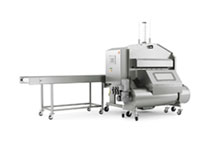-
Bag Loading:
NBE contaminant-control bag emptying product infeed projects are engineered in cooperation with the project owner to
promote safe, efficient operator performance. Optimal run rates, continuous run times, and effective operator ergonomics
are not incompatible objectives. Whether operators are controlling automated bag loading systems or are manually loading
bags, NBE bag emptying and infeed projects work to advance safety and performance.
- Automated Bag Loading: Production rate, material characteristics, labor allocations. Whatever the basis for automated bag loading, the proactive application analysis and engineering resources of NBE ETA project execution will ensure effective automation integration. From early-stage feasibility testing, through to factory acceptance tests and site acceptance tests, NBE robotic bag loading systems are performance-proven.
- Manual Bag Loading: For some material processing applications, manual loading of full bags onto a bag staging conveyor can be an appropriate and effective method of operator interaction. The bag staging conveyor, controlled by a variable frequency drive, meters the supply of full bags onto the transition conveyor prior to introduction to the bag opener.
- Bag Opener: Full bags, received from the bag staging conveyor, are automatically positioned on the transition conveyor for introduction to the bag opener sequence. The sequence begins as each bag is automatically advanced onto the bag retention tray inside the bag opener chamber. Once inside the chamber, precision-machined bag retention tines pierce the bag to prevent the bag from entering the process stream. A multi-edge, multi-point cutting blade penetrates through the entire width and depth of the bag. The opened bag halves, secured to the retention tray by the retention tines, are tilted down 90-degrees to enable contents to empty from the bag halves into the integrated material hopper. Emptied bag halves, retained on the trays, are returned to the introduction point. The emptied bags are automatically discharged into the integrated bag compactor; completing the bag emptying cycle.
-
Infeed Product Takeaway:
Downstream product supply requirements can range from simple to complex. Factors such as supply rate, transfer distance, and
number of end supply points all influence the design and engineering of an in-plant material handling and storage systems. NBE
process-specific design and engineering will provide performance-proven mechanical and automation integration across the
fullstream project.
- Screw Conveyor
- Bi-directional Screw Conveyor
- Belt Conveyor
- Bucket Elevator
- Pneumatic Conveying
- Flanged Discharge
- Empty Bag Compactor: Bag halves, emptied of their contents, enter the bag compactor from the bag opener chamber. Completely enclosed, and with a hinged protective cover, the NBE bag compactor uses an 18-inch diameter, slow-rotating, high-torque compression screw to press emptied bag halves into the collector sleeve. Collected bag material is ready for recycling or other handling.
-
Dust Collection:
During the bag emptying and product infeed stages, some bagged products, and packaging material itself, can create dust. NBE
application-specific design, manufacturing, and integration of dust management systems enables the reintroduction to the product
stream of collected and filter product; improving process yield. Preventing the release of process dust into the workplace helps
protect labor from airborne dusts and reduces facility and equipment maintenance.
- Dedicated Dust Collector
- Dust Collection Pick-up Port
- Central Dust Collection System Integration
Reduce Product Contamination Concerns and Increase Process Yield Performance
When stringent product safety demands and exacting yield targets are absolute process requirements, NBE contaminant-control bag emptying and infeed systems provide critical protection of input material and the process stream from packaging fibers and other contaminants. Throughout the entire bag opening and product infeed sequence, the bag is kept out of, and away from, the product stream. Every application of the NBE contaminant-control bag emptying and infeed system is engineered, constructed, and integrated to the particular specifications of each process operation. NBE engineered-to-application (ETA) project execution employs advanced process modeling and material testing, together with expertise across engineering, automation, manufacturing, and systems integration practices to ensure contaminant-controlled, high-yield infeed performance.




